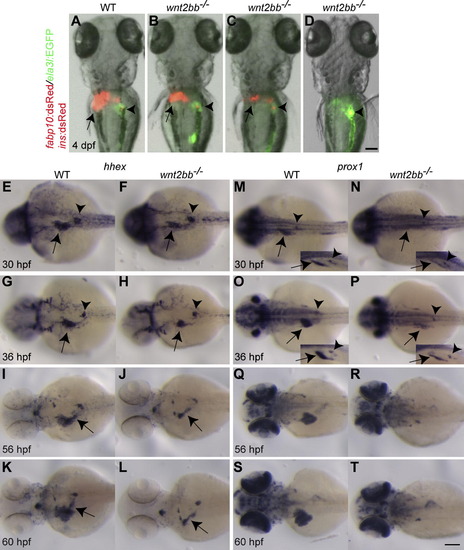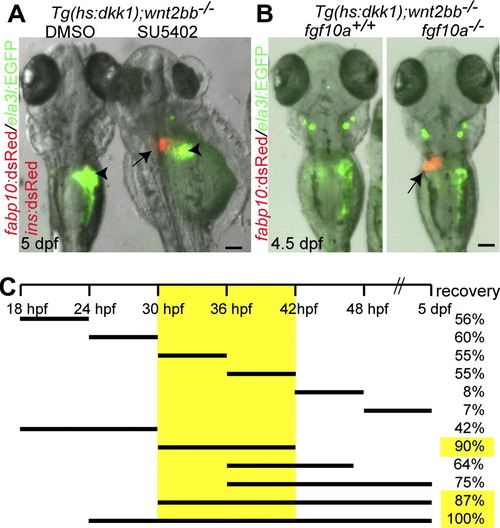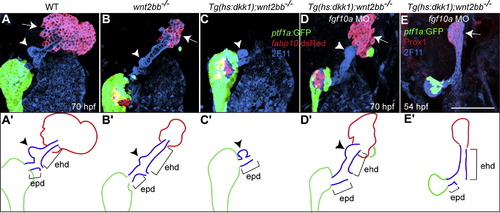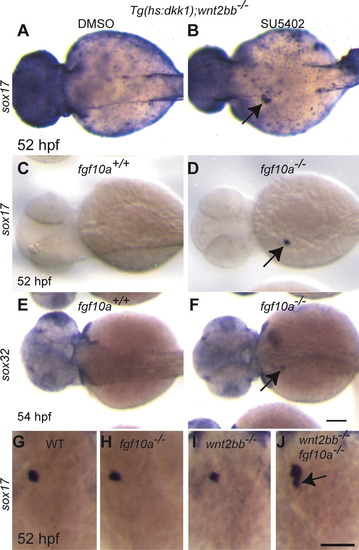- Title
-
Intrinsic and extrinsic modifiers of the regulative capacity of the developing liver
- Authors
- Shin, D., Weidinger, G., Moon, R.T., and Stainier, D.Y.
- Source
- Full text @ Mech. Dev.
|
Liver formation and the expression patterns of two hepatoblast markers, hhex and prox1, in wnt2bb mutants. (A-D) The Tg(fabp10:dsRed,ela3l:EGFP);Tg(ins:dsRed) line was used to reveal the liver (red), acinar pancreas (green), and pancreatic beta cells (red). Arrows point to the liver, arrowheads to the endocrine pancreas. The liver formed in most wnt2bb mutants (B and C), but its size was variable and smaller than wild-type. Dorsal views, anterior up. (E-T) hhex expression in the liver-forming region was weakly reduced in wnt2bb mutants compared to wild-type at 30 and 36 hpf (F and H, arrows), whereas prox1 expression was greatly reduced (N and P, arrows). hhex expression in the dorsal pancreas (E-H, arrowheads) and prox1 expression in the interrenal primordium (M-P, arrowheads) appeared unaffected in wnt2bb mutants compared to wild-type. To better visualize hepatic prox1 expression, side-view images are shown in an inset (M-P). Both hhex and prox1 are expressed in the developing liver, but only hhex is expressed in the extrahepatic duct (I-L, arrows). This extrahepatic duct expression appears unaffected in wnt2bb mutants (J and L, arrows). Dorsal views, anterior to the left. Scale bars, 100 µm. |
|
Loss of Wnt/β-catenin signaling does not affect the formation of the extrapancreatic duct. (A-F) hhex (A-C) and prox1 (D-F) expression in the liver-forming region (arrows) at 42 hpf was further reduced in Wnt/β-catenin signaling deficient embryos compared to wnt2bb mutants. However, hhex expression in the dorsal pancreas appeared unaffected (A-C, arrowheads). (G-I) foxa3 expression was examined to reveal the overall gut morphology. A small liver bud formed in wnt2bb mutants at 56 hpf (H), whereas it did not form in Wnt/β-catenin signaling deficient embryos (I). Arrows point to the liver-forming region. Dorsal views, anterior to the left. (J-L) The extrahepatic and extrapancreatic ducts (ehd and epd) were revealed by mAb 2F11 staining, the exocrine pancreas by Tg(ptf1a:GFP) expression, and the liver by Prox1 expression (arrows). Both the liver and the extrahepatic duct failed to form in Wnt/β-catenin signaling deficient embryos (L). Ventral views, anterior up. Scale bars, 100 µm. |
|
sox17 and sox32 are expressed in the forming liver of wild-type and wnt2bb mutant embryos. (A-F) sox17 (A-C, arrows) and sox32 (D-F, arrows) are re-expressed in the endoderm at 48 and 72 but not 25 hpf. Dorsal views, anterior to the left. (G-J) sox17 in situ hybridization combined with anti-GFP immunostaining in Tg(gutGFP)s854 embryos reveals sox17 expression (red) in the liver (brackets) and later in the gallbladder (I, arrowhead). At 48 hpf, most of the hepatic bud tissue (brackets) in wnt2bb mutants expressed sox17 (J). Ventral views, anterior up. (K-R) Hepatic sox17 and sox32 expression was absent in Wnt/β-catenin signaling deficient embryos (N and R), whereas it was present in wnt2bb mutants (M and Q) andTg(hs:dkk1-GFP) embryos heat-shocked at 18 hpf (L and P). Dorsal views, anterior to the left. Scale bars, 100 µm. EXPRESSION / LABELING:
PHENOTYPE:
|
|
Sox32 positively regulates liver formation in wnt2bb mutants. (A) Schematic of the dominant-negative Sox32 construct. The transcriptional repressor domain of Drosophila Engrailed was fused to the HMG box (gray box) of Sox32. (B-E) mRNA injections into Tg(sox17:GFP) embryos reveal that dnSox32 blocks Sox32 function. Injections of sox32 mRNA enhanced GFP expression driven by the sox17 promoter; injections of dnsox32 mRNA reduced it. Co-injections of sox32 and dnsox32 mRNA blocked GFP induction by Sox32. Dorsal views, anterior up. (F-H) Hepatic sox17 expression was almost absent (G, 60%) or greatly reduced (H, 40%) in Tg(hs:dnsox32) embryos heat-shocked at 26 hpf (n = 10). Dorsal views, anterior to the left. (I-L) Tg(hs:dnsox32);wnt2bb-/- embryos were heat-shocked at 26 hpf, and examined at 5.5 dpf. The liver (arrows) formed in all Tg(hs:dnsox32), but failed to form in most Tg(hs:dnsox32);wnt2bb-/- embryos (L, 22 out of 25). Side views, anterior up. Scale bars, 100 µm. |
|
fgf10a signaling negatively regulates liver formation in wnt2bb mutants. (A) Wnt/β-catenin signaling deficient embryos were treated with SU5402 (1 µM) from 26 hpf onward, and examined at 5 dpf. The liver (arrow) formed in SU5402-treated embryos despite severe morphological defects in the head and trunk. Arrowheads point to the endocrine pancreas. (B) The liver (arrow) also formed in fgf10a-/-; Wnt/β-catenin signaling deficient embryos. Dorsal views, anterior up. Scale bars, 100 µm. (C) The time-window critical for Fgf function in liver formation was delineated by treating Wnt/β-catenin signaling deficient embryos with SU5402 at multiple time points and for different duration (black bars); recovery indicates the percentage of embryos showing a liver at 5 dpf (n = 9-23 for each treatment). |
|
Both the liver and the extrahepatic duct form in Wnt/β-catenin signaling deficient embryo slacking Fgf10a function. Tg(hs:dkk1-GFP);wnt2bb-/- embryos were injected with fgf10a MO, heat-shocked at 18 hpf, and examined at 54 (E) or 70 (D) hpf. The extrahepatic duct was revealed by mAb 2F11 staining, the exocrine pancreas by Tg(ptf1a:GFP) expression, and the liver by Tg(fabp10:RFP) (A-D) or Prox1 (E) expression. Both the liver (arrows) and the extrahepatic duct (ehd) failed to form in Wnt/β-catenin signaling deficient embryos (C), whereas they did form when these embryos were injected with fgf10a MO (D and E). The gallbladder (arrowheads) formed in the extrahepatic duct when the liver formed, whereas it formed in the extrapancreatic duct (epd) when the liver failed to form (C). (A′-E′) The liver, the extrahepatic and extrapancreatic ducts as well as the pancreas are schematically illustrated. Ventral views, anterior up. Scale bar, 100 µm. |
|
Hepatic sox17 and sox32 expression in wnt2bb mutant and Wnt/β-catenin signaling deficient embryos lacking Fgf10a function. (A-F) Hepatic sox17 expression was present in Wnt/β-catenin signaling deficient embryos treated with SU5402 (1 µM) from 30 to 44 hpf (B) as well as in Wnt/β-catenin signaling deficient embryos lacking Fgf10a function (D). Hepatic sox32 expression was also present in these embryos (F). Dorsal views, anterior to the left. (G-J) There was no clear difference in the hepatic sox17 expression domain among wild-type, fgf10a-/- and wnt2bb-/- embryos (G-I). However, it expanded into the extrahepatic duct region in most fgf10a-/-;wnt2bb-/- (J, five out of seven embryos). Dorsal views, anterior up. Scale bars, 100 µm. |
Reprinted from Mechanisms of Development, 128(11-12), Shin, D., Weidinger, G., Moon, R.T., and Stainier, D.Y., Intrinsic and extrinsic modifiers of the regulative capacity of the developing liver, 525-535, Copyright (2012) with permission from Elsevier. Full text @ Mech. Dev.







